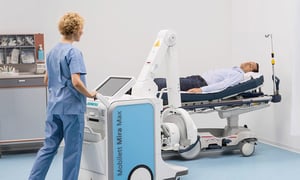 Reimbursement isn’t what it used to be.
Reimbursement isn’t what it used to be.
At the beginning of this year, the Centers for Medicare and Medicaid Services (CMS) started applying a 7% penalty to all reimbursements for Computed Radiography (CR) exams.
By all accounts, this hasn’t led to the widespread exodus away from CR systems that CMS was likely hoping would have taken place. According to research from the Advisory Board and the Association for Medical Imaging Equipment, 78% of survey respondents were still relying on CR imaging systems as of last July.
A few things to note about these statistics:
- Not all hospitals rely on CMS reimbursement as a major driver of revenue
- Critical access hospitals may have special exemptions
- Many facilities fear that the cost of replacement outweighs the penalty
All of these things are true, but they miss an underlying point: the industry is moving toward digital radiography, and it’s going to become harder and harder to keep your X-ray program financially viable as time moves on. In five years, the penalty will increase to 10%, making computed radiography unsustainable for many facilities.
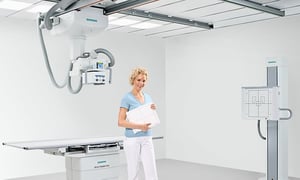 We’ve worked with numerous imaging centers, hospitals and other facilities to install digital X-ray equipment that ensures appropriate reimbursement and improves patient satisfaction. Because of this, we have a special vantage point to review the variety of options you have at your disposal in the current system.
We’ve worked with numerous imaging centers, hospitals and other facilities to install digital X-ray equipment that ensures appropriate reimbursement and improves patient satisfaction. Because of this, we have a special vantage point to review the variety of options you have at your disposal in the current system.
Here are a few of the ways you can approach the conversion to digital X-ray if you haven’t yet made the move.
- Continue the Current Course
This might be the right move for some hospitals, but the number of such facilities dwindles every year. You may analyze your financial reports and come to the conclusion that, even with the 7% hit to reimbursement, it still makes sense to stick with CR.
I would caution against remaining on this path for much longer. Not only will it continue to strain your bottom line, but you’re going to start risking a loss of patients if you haven’t experienced that decline in volume already. Digital X-ray provides a much more expedient imaging process and, given the trend toward consumerism in imaging, don’t be surprised if patients take a closer look at their options and visit the imaging center that’s using the most recent technology.
Think of it this way: there’s a reason the government has provided incentives to abandon CR and embrace DR. The entire reason for this switch is to provide a better diagnostic situation for the facility and a better experience for the patient. Put simply, the switch to DR is about improved episodes of care.
Thus, I would urge you to start giving consideration to the other options that are out there.
- Upgrade to Digital X-ray
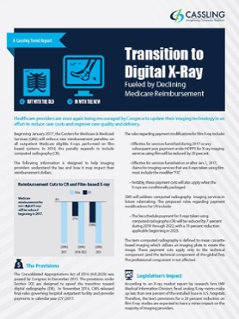 This is the ideal solution, and the good news is you have options when it comes to upgrading that can make the perceived financial cost less than you may anticipate. Here are a few things to consider:
This is the ideal solution, and the good news is you have options when it comes to upgrading that can make the perceived financial cost less than you may anticipate. Here are a few things to consider:
- Incentives can lessen the financial burden – If you’re upgrading not just one but a series of X-ray systems throughout your facility or the entirety of your health system, you may be able to reduce your cost by doing everything at once rather than piecemealing the system together. Bulk-buy programs can create significant cost-savings for your facility.
- Workflow analysis – Many vendors, Cassling included, will conduct a workflow analysis of your current situation to determine areas where you can save money and simultaneously improve processes. In addition, when you bring a digital fleet online, many of your current inefficiencies can be reduced or eliminated altogether. That’s great for providers and patients alike.
- Reduce service costs – A wide array of different systems often means multiple vendors and service providers. You can reduce costs dramatically by standardizing around a single fleet solution. One service contract means you’re able to get service from one trusted provider. And because you upgraded to digital, you’re working with staff well-versed on the latest equipment, and they won’t be hunting down parts for older systems. That’s a big deal, especially since old parts for old systems could also cost you downtime.
When all of this is taken together, you can begin to see how the transition to digital makes more financial sense than is perhaps apparent on the surface. But if you’re still not able to make that leap, even after crunching all the numbers, there’s one more option to consider.
- Retrofit Your Current X-ray Lineup
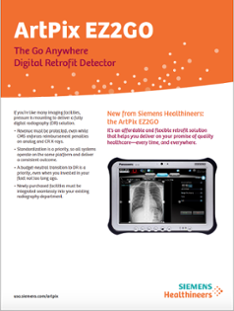 If you’re not yet ready to fully upgrade your fleet, but you also want to avoid the penalty that sticking with CR is going to cost you, then your best bet for the moment might be to retrofit your existing CR units.
If you’re not yet ready to fully upgrade your fleet, but you also want to avoid the penalty that sticking with CR is going to cost you, then your best bet for the moment might be to retrofit your existing CR units.
Here’s how it works: a vendor installs equipment that converts an existing unit into a wireless, digital solution that meets the specifications required to avoid the reimbursement penalty. This enables you to keep your current equipment, but it also has the advantage of tapping you into remote maintenance, improved workflows and outstanding digital imaging.
Siemens Healthineers has a retrofit solution called the ArtPix EZ2GO. Appropriate for both CR and analog X-ray equipment, the ArtPix EZ2GO has one additional benefit as well: it’s the perfect bridge to newer, fully digital X-ray systems once you’re ready to make the leap. You won’t have to get rid of it once you take that step either; it can integrate immediately with the other Siemens X-ray systems.
And if you don’t currently have a Siemens Healthineers system, that’s okay too, because it’s possible to install the ArtPix EZ2GO on other vendors’ equipment.
The Choice Is Yours
Those are your three main choices at this crucial juncture and, honestly, the first option is more of a short-term choice. You’re better off deciding between an outright upgrade or a retrofit solution. Doing so will ensure your reimbursement security in the future and help improve the experience for both patients and providers.
Let me know if you have any questions, and best of luck making the choice that’s right for you!

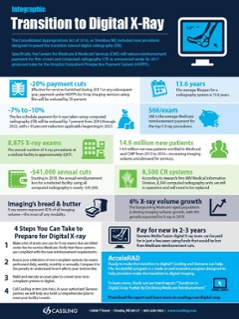





Comments